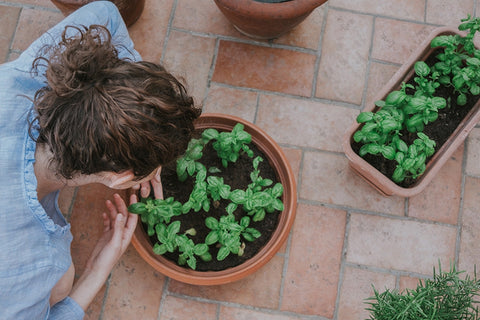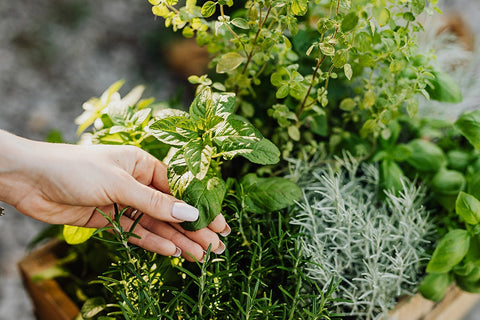Our Favorite Summer Herb
With the summer season officially upon us, you might be wondering which herbs can be planted now and still beat the heat. Lucky for you, one of our favorite kitchen staples just happens to thrive during the warm summer months: Basil!
Basil seedlings germinate well once soil temperatures warm to 70°F (18°C), but will still germinate (often faster) at warmer soil temperatures. Avoid direct seeding basil into cool wet soils in early spring or fall...wait until it's warm! Or, start your seeds early indoors.
In the Garden: Yes, you still have time in summer to direct seed basil into your garden or balcony pots. Wherever you have a bit of space.
How to Plant Basil Seeds

Basil grows quickly from seed, especially during warm summer months when soil temperatures are above 70°F. In the garden or in pots, plant two seeds per hole (just to make sure you get a healthy seedling) 1/4 inch deep. When soil temperatures are warm, sprouts typically appear in 5 days but can be as quick as three days or as long as seven days depending on the temperature.
If you are planting in rows in your garden, space your rows by about 18 inches and space your seeds about 8-12 inches apart so you leave them some room to grow into full healthy plants.
If you are planting seeds directly into patio or balcony pots, space your seeds out by about 2 inches.
Gently water in your seeds. Keep the soil consistently and evenly moist to the touch (but not soggy wet).
Week 1-2: Check for Sprouts
You could see seedlings in as little as 3 days (though 5 days is more typical). If it’s been 7 days and you still don’t have any sprouts, it could be seeds haven't gotten enough moisture, the soil is too cool, or your seed may be too old.
Week 2: Thin Your Seedlings

If you planted your seeds a bit too close in your garden or your pots, you should thin them. If both seeds in each hole germinate, snip off the smaller weaker one. By getting rid of the smaller weaker seedlings, you’re allowing the biggest and strongest one to flourish by reducing its competition for water, food, and space.
Week 4-6: How to Prune Basil Plants

Once your Basil plant has 3 sets of true leaves, you’re ready for the first prune. Cut off the top set of mature leaves, leaving the bottom two (it’s best to cut right above the pair of leaves - or the node - you’re keeping on the plant). Once these branches grow out (and each has a few sets of their own leaves), you can cut the tip - just as you did with the main stem.
Keep Growing! How to Harvest Basil
As your basil continues to grow, keep harvesting to encourage growth. If you only want a couple of leaves, pick leaves where new ones are emerging at the base. For a bigger harvest, cut off the stems directly. It's best not to harvest more than 1/3 of the plant at a time.
But My Basil is Flowering...Now What?
As temperatures warm up and days get longer, basil will start flowering. There's really no stopping it! So what do you do? Harvest regularly! If you're harvesting regularly, you'll be pinching off the tissue where flowers would develop. If you see flower buds forming, simply pinch them off between your fingers or use small herb snips. You'll need to stay on top of this pinching pretty regularly through the warm summer months.
You can also grow special varieties of slower-to-flower basil such as Everleaf.
Now, it's good to know that basil flowers can feed a lot of your local insects and pollinators. So if you have extra plants feel free to let them flower for the local wildlife! Plus, the flowers are beautiful and also make a nice cut arrangement in a vase on the kitchen table - smells great too!









There are no comments for this article. Be the first one to leave a message!